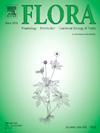Physiological responses of Illicium difengpi to simulated persistent and intermittent droughts
IF 1.8
4区 生物学
Q3 ECOLOGY
引用次数: 0
Abstract
Global climate change has intensified the impacts of persistent and intermittent droughts on karst plants, especially on endangered and medicinal species, but research in this area remains limited. This study investigated the effects of two types of droughts, i.e., persistent drought–rehydration (PD-R) and cyclic mild/moderate drought–rehydration (CD-R), on Illicium difengpi, an endangered medicine plant native to the karst regions in China, using two-years-old seedlings. Key physiological variables were measured throughout the experimental period. The leaf relative water content and predawn water potential of the species rapidly recovered to the control levels after rehydration. However, photosynthesis-related variables—including net photosynthetic rate (Pn), effective PSII quantum yield (ΦPSII), photochemical quenching coefficient (qP), chlorophyll concentration (Chl a+b), Chl a/b ratio—were positively correlated with soil moisture content (SM) but negatively correlated with drought cycles, leading to increasing decline with increased drought severity and frequency. Consequently, these variables failed to fully recover during the rehydration phase following severe drought or multiple CD-R cycles. Malondialdehyde (MDA) accumulation significantly increased during severe drought and the third CD-R cycle. Catalase (CAT) activity increased progressively with drought intensity under PD-R (60–291 %), while CD-R induced significant increases of 28–68 % (mild) and 44–170 % (moderate). Proline (Pro) and soluble proteins (SP) elevated significantly only under severe persistent drought stress, showing no significant change under CD-R. This study demonstrates that: (i) I. difengpi exhibits strong post-drought water recovery; (ii) drought damage increases with severity and frequency; (iii) CAT plays a key role in antioxidant defense, while Pro and SP primarily respond to severe or multiple drought cycles. These findings provide a preliminary understanding of the physiological response of I. difengpi to persistent and intermittent drought.
地风皮illicum对模拟持续干旱和间歇干旱的生理响应
全球气候变化加剧了持续和间歇性干旱对喀斯特植物的影响,特别是对濒危和药用植物的影响,但这方面的研究仍然有限。利用2年树苗,研究了持续干旱复水(PD-R)和循环轻度/中度干旱复水(CD-R)两种干旱类型对中国喀斯特地区濒危药用植物地风皮Illicium difengpi的影响。在整个实验期间测量关键生理变量。复水后叶片相对含水量和黎明前水势迅速恢复到对照水平。净光合速率(Pn)、有效PSII量子产率(ΦPSII)、光化学猝灭系数(qP)、叶绿素浓度(Chl a+b)、Chl a/b比与土壤含水量(SM)呈正相关,与干旱周期负相关,且随干旱严重程度和频率的增加而下降。因此,在严重干旱或多次CD-R循环后的补液阶段,这些变量未能完全恢复。丙二醛(MDA)积累在严重干旱和第三CD-R循环期间显著增加。在PD-R处理下,过氧化氢酶(CAT)活性随干旱强度的增加而逐渐增加(60 - 291%),CD-R处理下过氧化氢酶(CAT)活性显著增加28 - 68%(轻度)和44 - 170%(中度)。脯氨酸(Pro)和可溶性蛋白(SP)仅在严重持续干旱胁迫下显著升高,CD-R处理无显著变化。研究结果表明:(1)地凤壁具有较强的旱后水恢复能力;干旱损害随着严重程度和频率增加而增加;(iii) CAT在抗氧化防御中起关键作用,而Pro和SP主要响应严重或多次干旱循环。这些发现为地凤皮对持续干旱和间歇干旱的生理反应提供了初步认识。
本文章由计算机程序翻译,如有差异,请以英文原文为准。
求助全文
约1分钟内获得全文
求助全文
来源期刊

Flora
生物-植物科学
CiteScore
3.30
自引率
10.50%
发文量
130
审稿时长
54 days
期刊介绍:
FLORA publishes original contributions and review articles on plant structure (morphology and anatomy), plant distribution (incl. phylogeography) and plant functional ecology (ecophysiology, population ecology and population genetics, organismic interactions, community ecology, ecosystem ecology). Manuscripts (both original and review articles) on a single topic can be compiled in Special Issues, for which suggestions are welcome.
FLORA, the scientific botanical journal with the longest uninterrupted publication sequence (since 1818), considers manuscripts in the above areas which appeal a broad scientific and international readership. Manuscripts focused on floristics and vegetation science will only be considered if they exceed the pure descriptive approach and have relevance for interpreting plant morphology, distribution or ecology. Manuscripts whose content is restricted to purely systematic and nomenclature matters, to geobotanical aspects of only local interest, to pure applications in agri-, horti- or silviculture and pharmacology, and experimental studies dealing exclusively with investigations at the cellular and subcellular level will not be accepted. Manuscripts dealing with comparative and evolutionary aspects of morphology, anatomy and development are welcome.
 求助内容:
求助内容: 应助结果提醒方式:
应助结果提醒方式:


